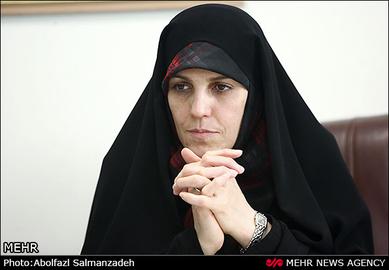Sima lives in the western Iranian city of Kermanshah. Last year she took nationwide entrance exams to get into university, and her first choice was Tehran University’s Medical School. But, despite the fact that she achieved good grades, she was unsuccessful in her application for medical school. When Sima and her father went to the National Testing Organization in Tehran — the third time they had done so — they discovered that Sima’s place had been given to a male student who had lower grades. The next year, Kermanshah’s Medical School accepted Sima on its course, but Sima had wasted a year of her life and was deprived of education at a more prestigious university.
In November of this year, Shahindokht Molaverdi, President Rouhani’s vice president for Women and Family Affairs, said that forced marriage and poverty were the major contributing factors in preventing women from getting an education. She did not, however, mention anything about bans on women at universities or the situation for young women like Sima.
Since 2009, the educational policies of the Islamic Republic have gradually turned more and more against women. Before 2009, around 65 percent of new university students were women. That same year, an official government announcement stated that, of the new student population, 49.5 percent were female and 50.5 were male.
Banned From 79 Fields
Since then, the government has implemented policies that ration acceptance at universities based on gender and geography. In certain fields, woman are only allowed into universities if the geographical rationing has room for them and, as a result, they are unable to study at better institutions of higher education. Currently 36 universities have imposed gender rationing in 79 fields. For example, Abadan’s Petroleum Engineering School currently does not accept any female applicants.
University professor and education and gender scholar Nahid Hoseini told IranWire: “With gender-geographical rationing, women are denied freedom of choice. They have no say in choosing their own fields of study. Sometimes these women remain at home and gradually lose their self-respect. They might have received high grades, but they are denied good education because of their gender. They are likely to come down with depression and feel frustrated.”
There is no question that with gender rationing, women are denied choice. A woman might be interested in carpentry but cannot pursue it because schools of higher education, including vocational schools, have made subjects gender-based. Boys are allowed to study carpentry, but girls must learn cooking and knitting. Sometimes women are deprived education even in fields that are traditionally considered to be “feminine” subjects. For example, in 2012, the University of Sistan refused to enroll women to study handicrafts.
“Under Ahmadinejad,” said Nahid Hoseini, “it was ordered that in fields such as engineering, universities must give 30 per cent of the places to boys and 30 per cent to girls. University authorities had discretion over what they did for the remaining 40 per cent.” She said that universities sought to give places to boys and men, regardless of their grades and knowledge. “This has been one of the most discriminatory decisions against women.”
Stealthy Expulsion
Elaheh Koulaei, a professor of political science and former member of parliament, refers to gender rationing as the “stealthy expulsion” of women from universities. She believes that such a policy is meant to change the balance of power and can only result in wasting Iran’s human capital.
But sexual discrimination in Iran’s higher education is not limited to rationing. In addition, classrooms are segregated and the actual courses taught to women are different. Taken together with the general social, political and economic policies of the Islamic Republic and its worldview that defines women only in the framework of the family, this shows a resolve to expel women from society at large, and place them into the confines of their homes.
In 2011, under President Ahmadinejad, women were banned from education in 77 fields. Later some of the bans were lifted, but a number of restrictions in engineering and technical fields remain.
Authorities often justify these policies by saying that unemployment among men is high and if one person has to be the family’s breadwinner then men must have priority.
Separate But not Equal
The process of separating classrooms on the basis of gender started under Ahmadinejad. Between 2010 and 2011, 16 universities separated their classrooms by gender. At some universities, including Amir Kabir University, even student canteens and laboratories were separated. But, in the face of practical realities, this policy did not succeed overall.
“In its implementation, the project kept the classrooms for men and took out a room outside the university for women,” said Hoseini. “Women were deprived from using facilities like the library, labs and sports equipment, or their access became limited. Since the universities did not have the wherewithal to provide equal facilities for men and women, many students protested and the project was abandoned. In my view and considering its timing, I believe the government wanted to prevent future movements in which men and women and men would stand side by side.”
There is, however, one exception to the rule. In nursing and medicine, women and men enjoy equal opportunities when it comes to enrolling. Of course, this is because that the preference is for female patients to go to female doctors — in other words, a continuation of sexual segregation after graduation. “A number of medical schools enroll men and women in equal numbers,” said Hoseini. “But they are not doing women any favors. To continue to make lifestyles Islamic, there must enough female doctors for woman patients. The same goes for teachers. The rationing for educating teachers, doctors and nurses is 50-50. That is why employment statistics show that the number of woman teachers and doctors is 13 to 17 per cent higher than men. If we take this group out, how many women are actually employed by the government?”
Sharia Instead of Women’s Studies
Of course, making sure universities were Islamic started with the inception of the Islamic Republic itself, and this has influenced what is actually taught. Thus “Women’s Studies” was replaced by “Islamic Women’s Studies,” which focuses on the role of women in an Islamic society. In other words, it deals with the same Sharia laws that women’s rights activists have criticized for decades.
Nahid Hoseini says authorities want men to study in the fields of industry, agriculture and finance — and they want to push women into fields like arts. “Looking at the statistics we find out that before Ahmadinejad, girls came first in mathematical and applied sciences at entrance exams, but just last year they were all boys. It is only logical that after 10 years of such policies these restrictions would leave their mark on girls.”
According to Hoseini, these policies discourage women from enrolling in engineering and technical courses. “If a girl in Iran wants to study engineering or carpentry she has to deal with a lot of discrimination and obstacles, both during her education and after she gets a job,” she said. “The daughter of a friend got her degree in architecture but now she is photographer. She says that the working environment for architects is very masculine and men treat women rudely.”
A recent report by the International Monetary Fund looks at how countries rank when it comes to gender gaps in various sections of society. In the gender gap table, Iran sits at 141 among 145 countries, along with Pakistan, Syria, Iraq and Yemen. Of course, the three of these countries are consumed by wars — an excuse that Iran and Pakistan cannot present as part of their own defense.
visit the accountability section
In this section of Iran Wire, you can contact the officials and launch your campaign for various problems

























comments